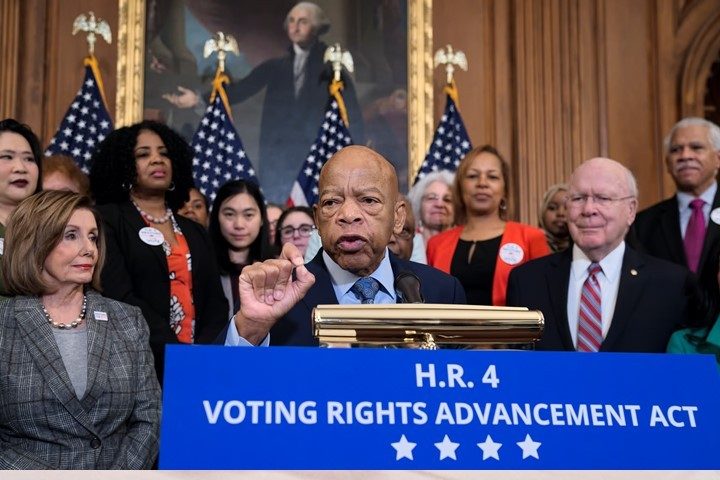
Senator Patrick Leahy (D-Vt.) recently introduced the John Lewis Voting Rights Advancement Act (JLVRA), named after the late U.S. Representative John Lewis (D-Ga.). This act, like many other recently proposed left-wing bills, including H.R.1, is yet another attempt to “federalize” and control the elections and to take power away from the states, all under the guise of protecting against state and local voter suppression laws. As such, it should be rejected.
The Constitution is very clear. Pursuant to Article I, Section 4, Clause 1:
The Times, Places and Manner of holding Elections for Senators and Representatives, shall be prescribed in each State by the Legislature thereof; but the Congress may at any time by Law make or alter such Regulations, except as to the Places of chusing Senators.
Therefore, generally speaking, it is up to the states to determine the time, place, and manner of elections. Congress can intervene if, for example, a law or regulation is discriminatory in nature.
Before the John Lewis Act Came the 1965 Voting Rights Act and Shelby
In Shelby County v. Holder, 570 U.S. 529 (2013), the Supreme Court issued a ruling pertaining to the Voting Rights Act of 1965 (“VRA”), which was originally passed to address racial discrimination in voting, which was prevalent at the time. There, the Court discussed several provisions of the VRA. One was Section 2, which forbids any “standard, practice, or procedure” that “results in a denial or abridgement of the right of any citizen of the United States to vote on account of race or color.” The provisions of Section 2 are permanent, apply nationwide, and were not at issue in Shelby.
While the Supreme Court was not concerned with Section 2, it did take issue with Section 4 and Section 5 of the VRA. Section 5 provided that “no change in voting procedures could take effect until it was approved by federal authorities in Washington, D.C. — either the Attorney General or a court of three judges.” In other words, before making any changes to the voting procedures, certain states would need to first obtain preapproval or permission from the federal government or a penal of judges.
To what states did this apply? When the VRA was first passed, Section 4 required only certain states to obtain preapproval. The Shelby court noted:
At the time of the Act’s passage, these “covered” jurisdictions were those States or political subdivisions that had maintained a test or device as a prerequisite to voting as of November 1, 1964, and had less than 50 percent voter registration or turnout in the 1964 Presidential election. §4(b), 79 Stat. 438. Such tests or devices included literacy and knowledge tests, good moral character requirements, the need for vouchers from registered voters, and the like.
The Court noted that Congress has reauthorized and amended the VRA throughout the years. For example, Congress reauthorized the VRA in 2006, and Section 5 was amended to forbid “voting changes with ‘any discriminatory purpose’ as well as voting changes that diminish the ability of citizens, on account of race, color, or language minority status, ‘to elect their preferred candidates of choice.’”
While the VRA was periodically amended and renewed, the coverage formula had not been changed since 1975. This, according to the Shelby Court, was a fatal flaw, which led the Court to strike down a portion of the preclearance requirement. As the Court stated:
There is no valid reason to insulate the coverage formula from review merely because it was previously enacted 40 years ago. If Congress had started from scratch in 2006, it plainly could not have enacted the present coverage formula. It would have been irrational for Congress to distinguish between States in such a fundamental way based on 40-year-old data, when today’s statistics tell an entirely different story. And it would have been irrational to base coverage on the use of voting tests 40 years ago, when such tests have been illegal since that time. But that is exactly what Congress has done.
Our decision in no way affects the permanent, nationwide ban on racial discrimination in voting found in §2. We issue no holding on §5 itself, only on the coverage formula. Congress may draft another formula based on current conditions. Such a formula is an initial prerequisite to a determination that exceptional conditions still exist justifying such an “extraordinary departure from the traditional course of relations between the States and the Federal Government.” Presley, 502 U. S., at 500–501. Our country has changed, and while any racial discrimination in voting is too much, Congress must ensure that the legislation it passes to remedy that problem speaks to current conditions.
Stated differently, since the data that was used to establish which states had to obtain preclearance was many decades old, it could not be used as the basis to compel preclearance from states today, as the circumstances are vastly different. Rather, Congress has to develop a new coverage formula based on data that reflects the same terrible conditions in parts of America that were present in the Deep South when the VRA was first passed.
This makes complete sense, given that Section 5 appears to invade the rights that the individual states have over elections.
The John Lewis Voting Rights Advancement Act
In light of the Shelby decision, the JLVRAA seeks to reimpose the preclearance requirement based on a new coverage formula. Not only would the judicial approval requirement remain, but other and broader provisions would be added. In a recent article, Hans A. von Spakovsky, senior legal fellow at the Heritage Foundation, thoroughly explained some of the main components of the JLVRAA. According to von Spakovsky:
States would be covered in their entirety for ten years if the attorney general determined that ten “voting-rights violations” occurred during a 25-year period, even if the state was responsible for only one of them and the rest were committed by city or county governments over which the state had no authority.
Voting-rights violations would include objections made by the attorney general, which don’t require any finding of intentional discrimination. A claimed discriminatory effect based purely on a statistical disparity would count as a violation.
Consent decrees and lawsuit settlements would also count as voting-rights violations. This would provide an incentive for the Justice Department and advocacy groups to file as many lawsuits as possible against states, even if they had little or no merit, in order to obtain quick settlements that could then be used to trigger preclearance coverage.
Certain voting changes would automatically trigger preclearance requirements for jurisdictions. These would include any change in political boundaries during redistricting that resulted in reducing the population of a particular racial-minority group by three or more percentage points. They would also include any change requiring “proof of identity to vote” or “proof of identity to register to vote,” as well as any “change that reduces, consolidates, or relocates voting locations” in jurisdictions with a certain minimum percentage of minority voters. This is an obvious attempt to outlaw state voter-ID requirements.
Clearly, this bill is an effort to circumvent the Supreme Court’s ruling in Shelby. Additionally, it is another blatant attempt to give the Democrat-led Congress the power to control the elections. For example, under this bill, if the Justice Department files suit and seeks preliminary injunctive relief against a state, the plaintiff would only have to “raise a serious question” about whether the challenged voting change violated the VRA or the Constitution. This appears to be a very low threshold.
Congress should reject the JLVRAA. As with H.R.1, it is a blatant attempt to circumvent the constitutional powers and rights that the states are given with respect to the election process. It is also a bill that ignores the concept of federalism. Finally, it is a bill that, if successful, would bring the Democrats in Congress one step closer to their ultimate goal, which revolves exclusively around power and control at any cost.




